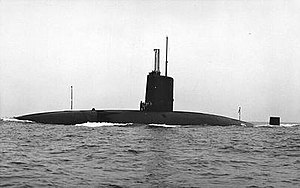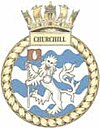
The Sturgeon class was a class of nuclear-powered fast attack submarines (SSN) in service with the United States Navy from the 1960s until 2004. They were the "workhorses" of the Navy's attack submarine fleet throughout much of the Cold War. The boats were phased out in the 1990s and early 21st century, as their successors, the Los Angeles, followed by the Seawolf and Virginia-class boats, entered service.

The Swiftsure class was a class of nuclear-powered fleet submarines in service with the Royal Navy from the early 1970s until 2010.

An attack submarine or hunter-killer submarine is a submarine specifically designed for the purpose of attacking and sinking other submarines, surface combatants and merchant vessels. In the Soviet and Russian navies they were and are called "multi-purpose submarines". They are also used to protect friendly surface combatants and missile submarines. Some attack subs are also armed with cruise missiles, increasing the scope of their potential missions to include land targets.

The Tang-class submarines were the first submarines designed and built by the United States Navy after World War II. They incorporated the best features of the high-speed German Type XXI U-boat and the venerable U.S. Navy fleet submarine. The Tang class, with the fleet submarines converted under the Greater Underwater Propulsion Power (GUPPY) program, had much higher submerged performance than their predecessors, but were quickly surpassed by the nuclear-propelled submarines that entered service beginning in 1954. Six units in total were built.

The Skate-class submarines were the United States Navy's first production run of nuclear-powered submarines. They were an evolution of the Tang class in everything except their propulsion plants, which were based on the operational prototype USS Nautilus. The four Skate class boats re-introduced stern torpedo tubes. Although among the smallest nuclear-powered attack submarines ever built, the Skate class served for many years, with the last being decommissioned in 1989. USS Skate was the first submarine to surface at the North Pole, on 17 March 1959.

The seventh Royal Navy ship to be named HMS Dreadnought was the United Kingdom's first nuclear-powered submarine, built by Vickers Armstrongs at Barrow-in-Furness. Launched by Queen Elizabeth II on Trafalgar Day 1960 and commissioned into service with the Royal Navy in April 1963, she continued in service until 1980. The submarine was powered by a S5W reactor, a design made available as a direct result of the 1958 US–UK Mutual Defence Agreement.

The Valiant class were a class of nuclear-powered fleet submarines in service with the Royal Navy from the mid-1960s until 1994. They were the first fully British nuclear fleet submarine; the earlier HMS Dreadnought used an American nuclear reactor. There were only two boats in the class, the first, Valiant commissioned in 1966 three years after Dreadnought, and Warspite the following year. Both were built by Vickers at Barrow-in-Furness.
The Rolls-Royce pressurised water reactor (PWR) series has powered the Royal Navy's nuclear submarines since the Valiant class, commissioned in 1966.
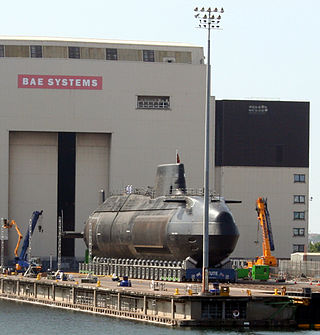
A nuclear submarine is a submarine powered by a nuclear reactor, but not necessarily nuclear-armed. Nuclear submarines have considerable performance advantages over "conventional" submarines. Nuclear propulsion, being completely independent of air, frees the submarine from the need to surface frequently, as is necessary for conventional submarines. The large amount of power generated by a nuclear reactor allows nuclear submarines to operate at high speed for long periods, and the long interval between refuelings grants a virtually unlimited range, making the only limits on voyage times being factors such as the need to restock food or other consumables. The limited energy stored in electric batteries means that even the most advanced conventional submarine can remain submerged for only a few days at slow speed, and only a few hours at top speed, though recent advances in air-independent propulsion have somewhat ameliorated this disadvantage. The high cost of nuclear technology means that relatively few of the world's military powers have fielded nuclear submarines. Radiation incidents have occurred within the Soviet submarines, including serious nuclear and radiation accidents, but American naval reactors starting with the S1W and iterations of designs have operated without incidents since USS Nautilus (SSN-571) launched in 1954.

The Le Redoutable-class submarine was a ballistic missile submarine class of the French Navy. In French, the type is called Sous-marin Nucléaire Lanceur d'Engins (SNLE), literally "Missile-launching nuclear submarine". When commissioned, they constituted the strategic part of the naval component of the French nuclear triad, then called Force de frappe.

The latest HMS Warspite was the third of Britain's nuclear-powered submarines, and the second of the Valiant class. After entering service in 1967 she collided with a Soviet submarine the following year. A mechanical failure associated with the submarine's nuclear reactor in 1991 led to the boat being laid up at HMNB Devonport where she awaits disposal.
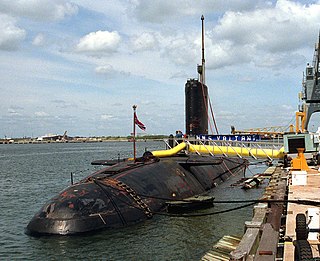
The sixth and most recent HMS Valiant was the second of Britain's nuclear-powered submarines, and the first of the two-unit Valiant class.

HMS Sealion (S07) was a Porpoise-class submarine.

An SSN is a nuclear-powered general-purpose attack submarine. SSN is the US Navy hull classification symbol for such vessels; the SS denotes a submarine and the N denotes nuclear power. The designation SSN is used for interoperability throughout NATO under STANAG 1166, though navies use other terms.

HMS Repulse (S23) was a Resolution-class ballistic missile submarine of the Royal Navy.

HMS Renown (S26) was the third of the Royal Navy's Resolution-class ballistic missile submarines.

HMS Revenge (S27) was the fourth of the Royal Navy's Resolution-class ballistic missile submarines.
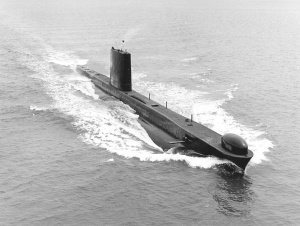
HMS Rorqual (S02) was a Porpoise-class submarine launched in 1956. She was built by the Vickers shipyard in Barrow-in-Furness, Cumbria, England. The boat was named for both the rorqual, a family of whale, and the earlier Second World War-era submarine of the same name.

HMS Narwhal (S03) was a Porpoise-class submarine of the Royal Navy. She was launched on 25 October 1957.

The Dealey-class destroyer escorts were the first post-World War II escort ships built for the United States Navy.
